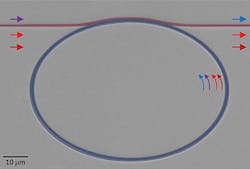Nonlinear nanoresonator shifts light's wavelength at single-photon level
Converting a single photon from one frequency to another is an essential tool in quantum communications. Scientists at the National Institute of Standards and Technology (NIST; Gaithersburg, MD) and the University of Maryland (College Park, MD) have developed a nanophotonic frequency converter comprising a ring-shaped resonator about 80 μm in diameter and a few tenths of a micrometer in thickness. The shape and dimensions of the silicon nitride ring waveguide are chosen to enhance the nonlinear optical properties of the material. The scientists have been working on the technology for a while; in 2013 they unveiled a nonresonant version of the device.
Frequency converters are essential for addressing two problems. The frequencies at which quantum systems optimally generate and store information are typically much higher than the frequencies required to transmit that information over kilometer-scale distances in optical fibers. Converting the photons between these frequencies requires a shift of hundreds of terahertz.
A much smaller, but still critical, frequency mismatch arises when two quantum systems that are intended to be identical have small variations in shape and composition. These variations cause the systems to generate photons that differ slightly in frequency instead of being exact replicas, which the quantum communication network may require.
The new ring resonator is driven by two pump lasers with different frequencies. Using four-wave-mixing Bragg scattering, a photon entering the ring is shifted in frequency by an amount equal to the difference in frequencies of the two pump lasers.
Upconversion from 1550 to 980 nm and downconversion from 980 to 1550 nm were accomplished at conversion efficiencies of greater than 60%.
Rather than using a few watts of power, as typical in previous experiments, the system consumes only about a hundredth of that amount. Importantly, the added amount of noise is low enough for future experiments using single-photon sources.
Source: http://www.nist.gov/cnst/new-nanodevice-shifts-lights-color-at-single-photon-level.cfm
REFERENCE:
1. Q. Li, M. Davanço, and K. Srinivasan, Nature Photonics (2016); doi: 10.1038/nphoton.2016.64.

John Wallace | Senior Technical Editor (1998-2022)
John Wallace was with Laser Focus World for nearly 25 years, retiring in late June 2022. He obtained a bachelor's degree in mechanical engineering and physics at Rutgers University and a master's in optical engineering at the University of Rochester. Before becoming an editor, John worked as an engineer at RCA, Exxon, Eastman Kodak, and GCA Corporation.
